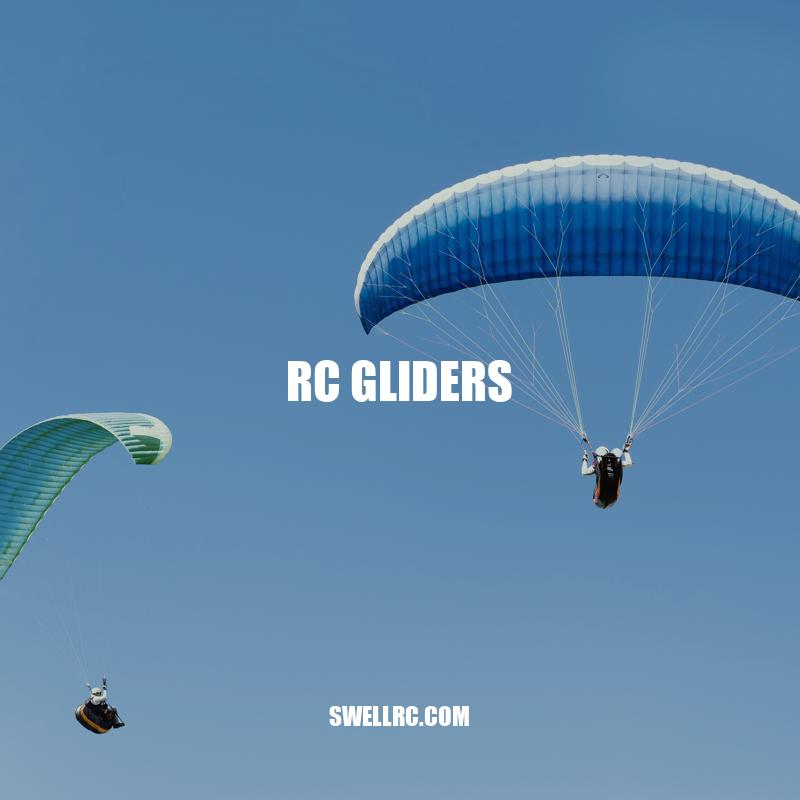Guide to RC Gliders: Soaring through the Skies
RC Gliders: Soaring Through the Skies
The thrill of soaring through the skies is a unique experience that many aviation enthusiasts and hobbyists crave. But, have you ever considered the eco-friendly way of achieving this through RC gliders? RC gliders are remote-controlled aircraft that use thermal currents to soar for extended periods in the sky. They come in an array of sizes, shapes, and types, from the slope soarers, electric gliders, and hand launch gliders. With continuous radical changes and adaptations in the RC glider industry, there is now a type of glider suitable for both beginners and pros.
RC gliders provide an exciting and rewarding experience in contrast to other RC aircraft that primarily operate through battery-powered engines. The gliders rely on thermal updrafts to glide and make use of the natural elements. This eco-friendly element has contributed to the increased popularity of RC gliding, especially among environmental enthusiasts. The elegant and graceful nature of RC gliders in flight adds to the allure of the aircraft. They provide a tranquil and almost therapeutic reminiscent experience to anyone interested in gliding through the skies. However, it requires specific gear, knowledge, and pre-flight checks to take your glider into the skies. In the next sections, we’ll explore the types of RC gliders available, the essential gear, and tips for RC glider flights.
RC gliders come in different shapes and sizes, each suited to different flying conditions and ideal for different skill levels. Here are some common types of gliders available:
- Slope Soarers: These types of gliders require steep hills or slopes with strong winds for gliding. They are perfect for experienced pilots.
- Hand Launch Gliders: These types of gliders have a small wingspan and are launched by hand. They are perfect for beginners.
- Electric Gliders: These gliders make use of electric motors to keep them in the sky. They are mostly used for silent flying, with some capable of reaching high speeds.
- Discus Launch Gliders: These gliders have a unique launching system that allows you to reach higher altitudes.
When choosing an RC glider, consider your skill level, the flying conditions of where you intend to practice, and the cost of purchase. Having an overview of these different types of gliders can help you select the one that suits your desired flying experience. Visit RC Groups for more in-depth discussions on different RC glider types and to connect with fellow glider enthusiasts.
What are the different types of glider?
There are various types of gliders, and each has unique features and uses. Paper airplanes are the easiest and simplest gliders to construct and operate. They are popular among children and help them develop hand-eye coordination skills while having fun. Toy gliders made of balsa wood or Styrofoam are other affordable options for beginners and students to learn the basics of aerodynamics. Hang-gliders are piloted aircraft with cloth wings and minimal structures and are ideal for gliding enthusiasts who want to experience the thrill of soaring.
RC gliding requires specific gear that is vital for smooth flights. Before taking to the skies, here is a list of essential gear you’ll need:
Equipment Description
– Radio Transmitter and Receiver To control and receive signals from the RC glider.
– Servos To move and control the glider’s parts, such as the wings and the rudder.
– Battery and Charger (Electric Gliders) To power the electric motor and charge the battery.
– Power Supply To make sure your equipment stays powered and ready for use.
– Carbon Fiber Rods or Tubes and Adhesive Tapes To reinforce the glider’s wings and keep it lightweight and aerodynamic.
RC gliding gear can be expensive, but it’s essential to invest in quality gear, especially if you’re serious about becoming a pro. However, don’t let the cost stop you, particularly if you want to try it out before investing in top-tier gear. There are usually cheaper options to consider. For instance, some beginner glider sets come with everything you need to get airborne. Amazon, Horizon Hobby, and A Main Hobbies are some of the stores you can check out for RC gliding gear.
Now that you have an idea of the essential gear to have, the next step is to learn how to master RC glider flights. Understanding some tips and tricks can help you avoid mistakes and improve your skills.
What aspect ratio for RC glider wings?
For RC glider wings, it is recommended to have an aspect ratio between 4.5 and 7.5. Higher aspect ratios are found in gliders with long wing spans, while lower aspect ratios are associated with shorter wing spans. No specific product or website was mentioned in this answer.
Mastering RC Glider Flights
To become a pro at RC gliding, it’s essential to know the right techniques. Here are some tips and tricks to help you master RC glider flights:
- Choose the right weather conditions: Sunny and hot days are ideal for RC gliding since it creates thermal currents that gliders can use to gain altitude. However, flying on a cloudy or overcast day will make flying difficult since thermal currents are absent.
- Choose the right flying area: Open fields and parks that are free from trees and other obstacles are ideal flying areas. Avoid flying on windy days and select an area with minimal wind.
- Check your glider: Before each flight, check all the parts on your glider and make sure that everything is tightly secured. Ensure that all the control surfaces move in the correct direction before launching the glider.
- Learn to Launch: Take some time to practice different ways to launch your glider, such as a hand launch or using a bungee cord. Each method requires different techniques to get the glider airborne.
- Practice Different Techniques: Learn different flying techniques, such as soaring, loop, spins, and stall turns, to make your flights more exciting.
RC gliding requires patience and practice, so don’t be discouraged if you don’t get it right the first time. With time and persistence, you’ll develop the skills needed to become an RC gliding pro.
In conclusion, RC gliding is an excellent way to enjoy the tranquility and beauty of the skies. Understanding the various types of gliders, essential gear, and tips for flying are key to a successful flight. So, find a suitable RC glider, gear up, practice, and take to the skies for an unforgettable experience.



